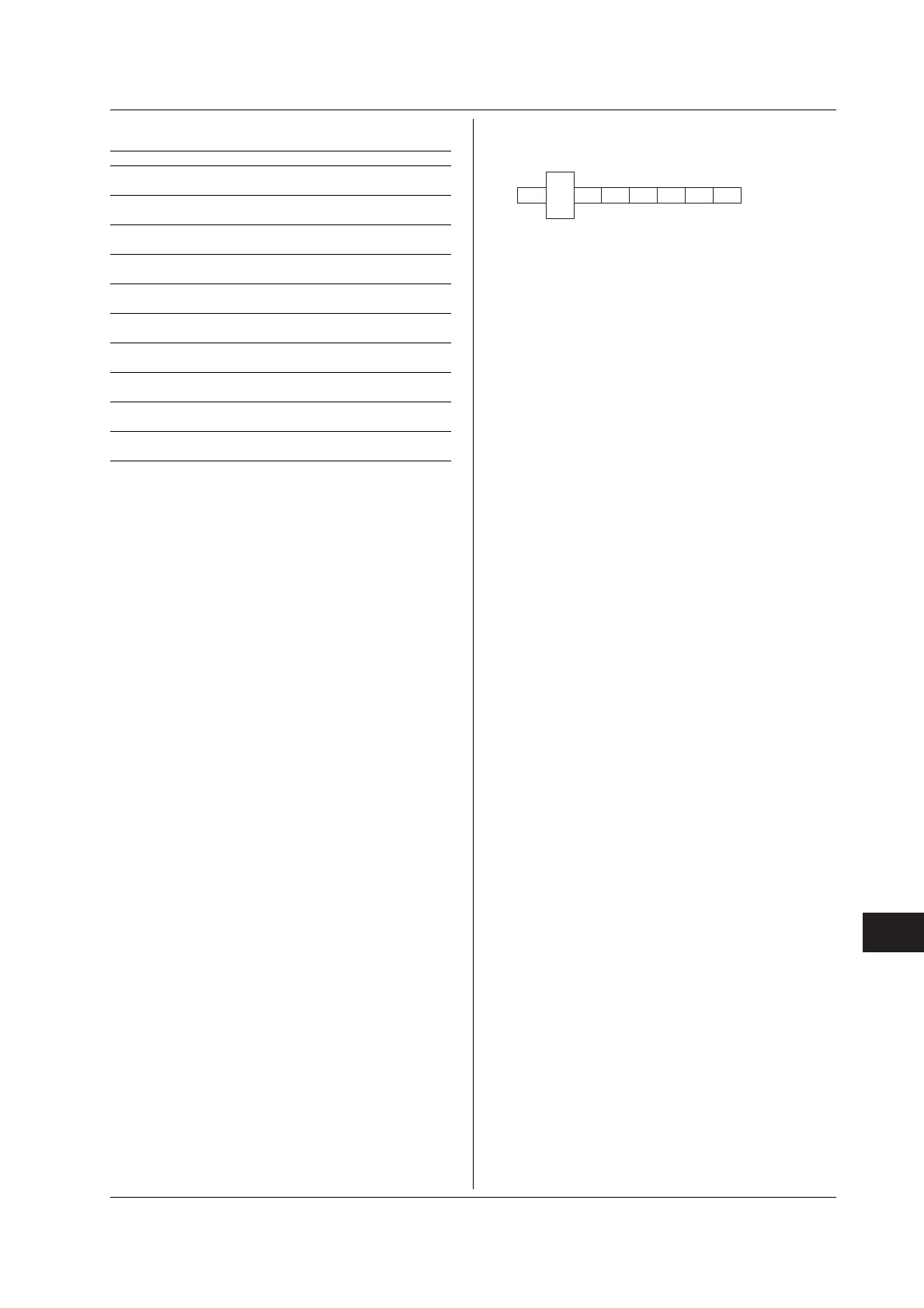14-45
IM 760401-01E
Communication Commands 2 (System of Commands Complying to the IEEE 488.2-1992 Standard)
14
Overview of Registers and Queues
Name Function Writing Reading
Status byte — Serial poll (RQS),
*STB?(MSS)
Service request Masks status byte. *SRE *SRE?
enable register
Standard event Event in the — *ESR?
register instrument (1)
Standard event Masks standard *ESE *ESE?
enable register event register.
Extended event Event in the — STATus:EESR?
register instrument (2)
Extended event Masks extended STATus:EESE STATus:EESE?
enable register event register.
Condition
Current instrument status
— STATus:CONDition?
register
Transition Extended event STATus:FILTer STATus:FILTer<x>
filter occurrence conditions <x>
Output queue
Stores response message All executable queues
to a query.
Error queue Stores error Nos. — STATus:ERRor?
and messages.
Registers and Queues which Affect the Status Byte
Registers which affect each bit of the status byte are
shown below.
Standard event register: Sets bit 5 (ESB) of status byte to “1” or “0”.
Output queue: Sets bit 4 (MAV) of status byte to “1” or “0”.
Extended event register: Sets bit 3 (EES) of status byte to “1” or “0”.
Error queue: Sets bit 2 (EAV) of status byte to “1” or “0”.
Enable Registers
Registers which mask a bit so that the bit does not
affect the status byte, even if the bit is set to “1,” are
shown below.
Status byte: Masks bits using the service request enable register.
Standard event register: Masks bits using the standard event enable register.
Extended event register: Masks bits using the extended event enable register.
Writing/Reading from Registers
The *ESE command is used to set bits in the standard
event enable register to “
1” or “0,” and the *ESR?
query is used to check whether bits in that register are
set to “
1” or “0.” For details of these commands, refer
to section 14.3.
14.4.2 Status Byte
Overview of Status Byte
76ESB MAV EES EAV 1 0
RQS
MSS
Bits 0, 1 and 7
Not used (always “0”)
Bit 2 EAV (Error Available)
Set to “1” when the error queue is not empty, i.e. when
an error occurs. For details, refer to page 14-44.
Bit 3 EES (Extended Event Summary Bit)
Set to “1” when a logical AND of the extended event
register and the corresponding enable register is “1,”
i.e. when an event takes place in the instrument. Refer
to page 14-47.
Bit 4 MAV (Message Available)
Set to “
1” when the output queue is not empty, i.e.
when there is data which is to be output when an
inquiry is made. Refer to page 14-44.
Bit 5 ESB (Event Summary Bit)
Set to “1” when a logical AND of the standard event
register and the corresponding enable register is “1”,
i.e. when an event takes place in the instrument. Refer
to page 14-46.
Bit 6 RQS (Request Status)/MSS (Master Summary
Status )
MSS is set to “
1” when a logical AND of the status byte
(except for bit 6) and the service request enable
register is not “
0,” i.e. when the instrument is
requesting service from the controller.
RQS is set to “1” when MSS changes from “0” to “1,”
and is cleared when a serial poll is performed or when
MSS changes to “
0.”
Bit Masking
To mask a bit in the status byte so that it does not
cause an SRQ, set the corresponding bit of the service
request enable register to “0.”
For example, to mask bit 2 (EAV) so that no service
will be requested, even if an error occurs, set bit 2 of
the service request enable register to “
0.” This can be
done using the *SRE command. To query whether
each bit of the service request enable register is “
1” or
“0,” use *SRE?. For details of the *SRE command,
refer to 14.3.
14.4 Status Report
